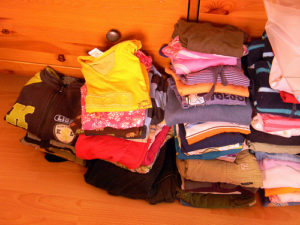 Buying clothes can consume a big chunk of your budget – especially if you have kids and teenagers. New clothes also take their toll on the planet, given how much water, pesticides and energy are required to produce cotton, polyester and other fabrics.
Buying clothes can consume a big chunk of your budget – especially if you have kids and teenagers. New clothes also take their toll on the planet, given how much water, pesticides and energy are required to produce cotton, polyester and other fabrics.
Amazing facts:
* 10% of all agricultural chemicals and 25% of insecticides in the U.S. are used to grow cotton.
* It takes almost 1/3 of a pound of chemicals (pesticides and fertilizers) to grow enough cotton for just one t-shirt.)
* Meanwhile, “out of style” clothes can end up in the trash even though they still have a lot of life left in them.
But it doesn’t have to be this way! Follow these green tips to green your wardrobe.
How to Green Your Wardrobe
First, make clothes last longer.
1. Buy gender-neutral clothes. Young children especially are usually willing to share shorts, t-shirts and sweatshirts, or wear hand-me-downs.
 2. Clean less frequently. Washing, drying and dry cleaning your clothes can wear fabric out and fade colors while using excessive amounts of water, and energy. Don’t wash clothes unless they’re actually dirty; hang on a line or on hangers to dry.
2. Clean less frequently. Washing, drying and dry cleaning your clothes can wear fabric out and fade colors while using excessive amounts of water, and energy. Don’t wash clothes unless they’re actually dirty; hang on a line or on hangers to dry.
3. Hold a swap meet. You may be tired of your clothes, but your neighbor, work colleague, or girlfriend might love them. Invite a group of friends over who are about the same size (or in a couple of close size ranges). Ask each to bring three to five items they’re ready to rotate out of their wardrobe for something different. Each person could leave with at least five new designs that they’ve swapped for their own old clothes.
4. Donate before you dispose. Dress for Success provides women looking for greater economic independence with business attire to wear to job interviews. One World Running ships donated running shoes, soccer gear, and baseball equipment to athletes in developing countries. Salvation Army will pick up clothes right from your door.
5. Recycle. Nike’s Reuse-A-Shoe grinds up and recycles discarded shoe material to build playground mats., basketball courts, and running tracks. Project Regeneration lets you recycle jeans you buy at Del Forte Denim.
Second, buy “green” when you shop.
6. Buy fewer, but higher-quality clothes. Traditional styles like blazers, jackets, and sweaters endure and are worth spending more money on. Buy just a few trendy items per season and “recycle” them at thrift shops or consignment stores once they’re truly passé for you.
7. Shop second-hand. One of my teenage daughter’s favorite boutiques is a consignment store where she rarely pays more than $15 for an outfit. She never goes shopping there unless she takes something from her closet to trade-in: It’s her favorite way of recycling. Plato’s Closet and Buffalo Exchange are two retailers to look for in addition to the shops in your own neighborhood.
8. Buy clothes made from organic, low-impact or recycled materials. Organic cotton, hemp, bamboo, and recycled fibers are the “green” rage.
9. Read the label. Avoid clothes that need dry cleaning, a process that usually involves perchloroethylene, a toxic chemical linked to various reproductive problems as well as headaches, nausea, and dizziness. When given the choice, hand wash over dry cleaning.
10. Make every day casual day. Dressy suits and standard business attire usually require dry cleaning to maintain their crisp, professional look. Encourage a “casual dress code” on the job so employees can dress in wash-and-wear clothing every day, not just “casual Fridays” or during more laid-back summer months.









